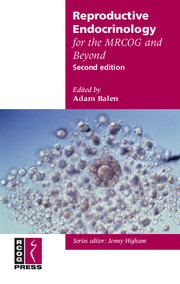Book contents
- Frontmatter
- Contents
- Acknowledgements
- Preface to the first edition
- Preface to the second edition
- Abbreviations used in this book
- 1 Sexual differentiation: intersex disorders
- 2 Adrenal disorders
- 3 Normal puberty and adolescence
- 4 Abnormal puberty
- 5 The menstrual cycle
- 6 Disorders of menstruation
- 7 Amenorrhoea
- 8 Polycystic ovary syndrome
- 9 Health consequences of polycystic ovary syndrome
- 10 Anovulatory infertility and ovulation induction
- 11 Lactation and lactational amenorrhoea
- 12 Hyperprolactinaemia
- 13 Thyroid disease
- 14 Diabetes
- 15 Lipid metabolism and lipoprotein transport
- 16 Premature ovarian failure
- 17 Calcium metabolism and its disorders
- Appendix: Endocrine normal ranges
- Further reading
- Index
15 - Lipid metabolism and lipoprotein transport
Published online by Cambridge University Press: 05 August 2014
- Frontmatter
- Contents
- Acknowledgements
- Preface to the first edition
- Preface to the second edition
- Abbreviations used in this book
- 1 Sexual differentiation: intersex disorders
- 2 Adrenal disorders
- 3 Normal puberty and adolescence
- 4 Abnormal puberty
- 5 The menstrual cycle
- 6 Disorders of menstruation
- 7 Amenorrhoea
- 8 Polycystic ovary syndrome
- 9 Health consequences of polycystic ovary syndrome
- 10 Anovulatory infertility and ovulation induction
- 11 Lactation and lactational amenorrhoea
- 12 Hyperprolactinaemia
- 13 Thyroid disease
- 14 Diabetes
- 15 Lipid metabolism and lipoprotein transport
- 16 Premature ovarian failure
- 17 Calcium metabolism and its disorders
- Appendix: Endocrine normal ranges
- Further reading
- Index
Summary
Fat absorbed from the diet and lipids synthesised by the liver and adipose tissue must be transported between the various tissues and organs for use and storage. As lipids are insoluble in water, the nonpolar lipids (triglycerides and cholesterol esters) are associated with amphipathic lipids (phospholipids and cholesterol) and proteins to make watermiscible lipoproteins. Lipids are transported in plasma as lipoproteins. Pure fat is less dense than water; therefore, as the proportion of lipid to protein in a lipoprotein increases, the density decreases. In addition to free fatty acids, there are four major groups of lipoproteins. These are:
• chylomicrons, derived from intestinal absorption of triacylglycerol
• very-low-density lipoproteins (VLDL), derived from the liver for the export of triacylglycerides
• low-density lipoproteins (LDL), representing a final stage in the catabolism of VLDL
• high-density lipoprotein (HDL) involved in VLDL and cholesterol metabolism and also in cholesterol transport.
Triacylglycerol is the predominant lipid in chylomicrons and VLDL (larger complexes), while cholesterol and phospholid are the predominant lipids in LDL and HDL (smaller complexes). A typical lipoprotein consists of a lipid core of mainly nonpolar triglyceride and cholesterol ester surrounded by a single surface layer of amphipathic phospholipid and free cholesterol and protein molecules. The protein moiety is known as apolipoprotein, constituting as much as 60% of HDL or as little as 1% of chylomicron particles. Some apolipoproteins are integral and cannot be removed, while others are free to transfer to other lipoproteins.
- Type
- Chapter
- Information
- Reproductive Endocrinology for the MRCOG and Beyond , pp. 171 - 176Publisher: Cambridge University PressPrint publication year: 2007



